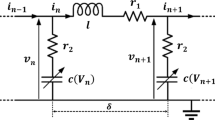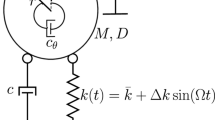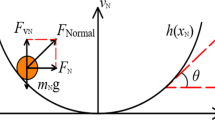Abstract
The propagation of a transverse disturbance along a tubular membrane enclosing a fluid medium and embedded in another is considered. It is shown that the velocity of propagation of such a disturbance can be identified with the velocity of the conduction process of thin-sheathed nerve fibers. The required values of the associated parameters, tension and pressure, appear not unreasonable. The results obtained indicate that experimental observations on the relation between the conduction velocity and the fiber diameter, as well as the effects of longitudinal stretching and transverse squeezing on the velocity of the conduction process in nerve, may be correlated on such a basis.
Similar content being viewed by others
Abbreviations
- a,A i ,A e :
-
amplitude constants
- c i ,c e :
-
acoustic velocity of internal and external fluid respectively
- k z :
-
=ω/V ω
- ΔP :
-
=P′ io -P′ eo
- P i ,P e :
-
pressure deviations from equilibrium in the respective media
- P i o,P e o :
-
deviations in pressure from equilibrium value at surface of membrane in respective media
- P′ i o,P′ e o :
-
pressure at membrane in the respective media
- P iA P eA :
-
pressure displacement amplitudes in respective media
- P iAo ,P eAo :
-
pressure displacement amplitudes in respective media at the membrane surface
- r :
-
radical coordinate
- r o :
-
radius of cylindrical membrane
- T :
-
tension per unit length in the membrane
- t :
-
time
- u r :
-
radial velocity
- V g :
-
group velocity
- V S :
-
signal velocity
- V ω :
-
phase velocity for sinusoidal disturbance on the membrane
- z :
-
coordinate, distance along membrane
- I o,K o,I 1,K 1 :
-
Bessel functions order zero and one, respectively
- ω:
-
2πf wheref is the frequency
- δ:
-
width of exciting pulse at half amplitude
- ϕ:
-
angular coordinate
- ξ:
-
radial displacement of membrane
- ξA :
-
radial displacement amplitude of membrane
- ρ i , ρ e :
-
densities of internal and external media, respectively
- σ:
-
mass of membrane per unit area
Literature
Blair, H. A. 1936. “The Time-Intensity Curve and Latent Addition in the Mechanical Stimulation of Nerve.”Am. Jour. Physiol.,114, 586–93.
Bullock, T. H. 1945. “Functional Organization of the Giant Fiber System of Lumbricus.”Jour. Neurophysiol.,8, 55–72.
Cole, K. S. and H. J. Curtis. 1939. “Electrical Impedance of the Squid Giant Axon during Activity.”Jour. Gen. Physiol.,22, 649–70.
Curtis, H. J. and K. S. Cole. 1942. “Membrane Resting and Action Potentials from the Squid Giant Axon.”Jour. Cell. Comp. Physiol.,19, 135–44.
Frank, O. 1926. “Die Theorie der Pulswellen.”Zeit. f. Biol.,85, 91–130.
Gasser, H. S. and J. Erlanger. 1929. “The Role of Fiber Size in the Establishment of a Nerve Block by Pressure or Cocaine.”Am. Jour. Physiol.,88, 581–91.
Grundfest, H. 1936. “Effect of Hydrostatic Pressure on the Excitability, the Recovery and the Potential Sequence of Frog Nerve.” Cold Spring Harbor Symp.,4, 179–87.
Guillemin, E. A. 1935.Communication Networks V.2. New York: John Wiley and Sons, Inc.
Hill, D. K. and R. D. Keynes. 1949. “Opacity Changes in Stimulated Nerve.”Jour. Physiol.,108, 278–81.
Hodgkin, A. L. and A. F. Huxley. 1945. “Resting and Action Potentials in Single Nerve Fibers.”Jour. Physiol.,104, 176–95.
— and W. A. H. Rushton. 1946. “The Electrical Constants of a Crustacean Nerve Fibre.”Proc. Royal Soc. Series B.,133, 444–79.
Morse, P. M. 1948.Vibration and Sound. New York: McGraw-Hill Book Co.
Prosser, C. L. 1946. “The Physiology of Nervous Systems of Invertebrate Animals.”Physiol. Rev.,26, 337–82.
Solomon, S. and J. M. Tobias. 1950. “Further Observations on Electrically Induced Transparency Changes in Nerve. Anodal Rigidity Cathodal Softening and the Effect of Several Ions.” (In preparation.)
Sutherland, W. 1905. “The Nature of the Propagation of Nerve Impulse.”Am. Jour. Physiol.,14, 112–19.
— 1906–07. “A Molecular Theory of the Electric Properties of Nerve.”Ibid.,17, 297–311.
— 1908–09. “The Nature of the Conduction of Nerve Impulse.”Ibid.,23, 115–30.
Tobias, J. M. 1950. “Qualitative Observations on Electrically Induced Transparency and Dimensional Changes and Quick Movements in Single Frog Axones.” Implications for Excitation, Propagation and the Transport of Materials Along Nerve.” (In preparation.)
Tobias, J. M. and S. Solomon. 1950. “Opacity and Diameter Changes in Polarized Nerve.”Jour. Cell. Comp. Physiol.,35, 25–37.
Watson, G. N. 1944. “A Treatise on the Theory of Bessel Functions.” 2nd. ed. London: Cambridge University Press.
Author information
Authors and Affiliations
Rights and permissions
About this article
Cite this article
Fry, W.J., Fry, R.B. Theoretical consideration of a possible mechanism in the conduction process of thin-sheathed nerve fibers. Bulletin of Mathematical Biophysics 12, 303–315 (1950). https://doi.org/10.1007/BF02477901
Issue Date:
DOI: https://doi.org/10.1007/BF02477901




